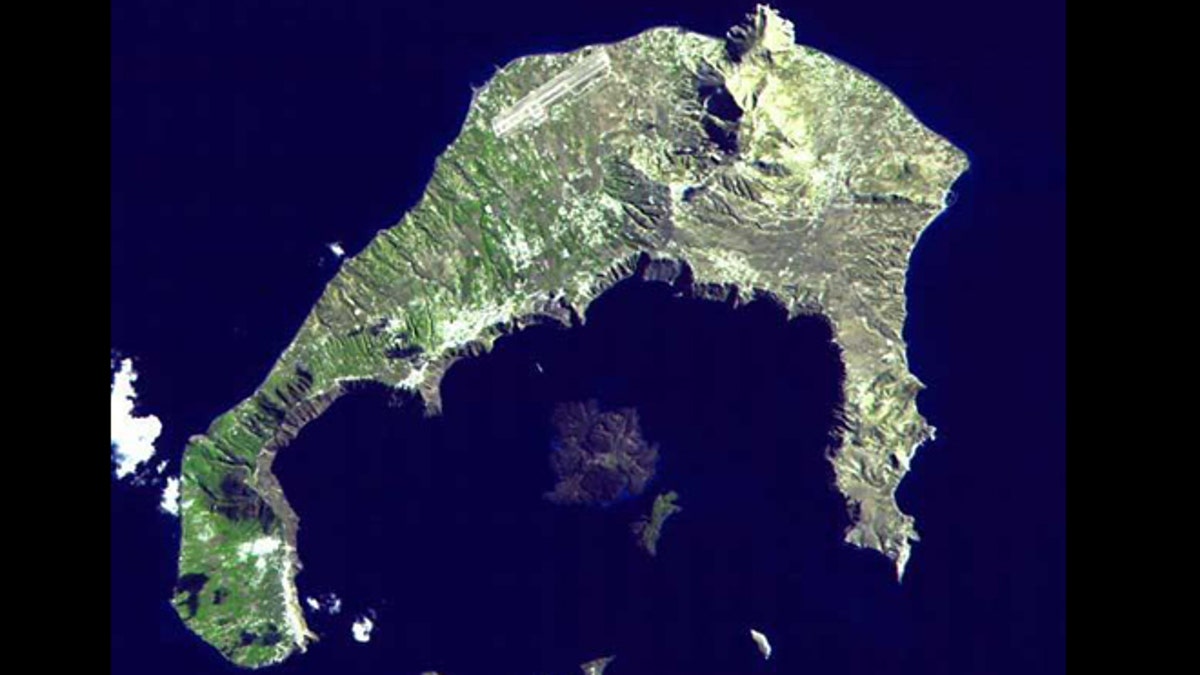
(NASA/GSFC/METI/ERSDAC/JAROS, and U.S./Japan ASTER Science Team)
The volcano that may have given rise to the legend of Atlantis has awakened, researchers say.
The cataclysmic eruptions at the Greek isle of Santorini about 3,600 years ago that spewed forth about 9.5 to 14.3 cubic miles (40 to 60 cubic kilometers) of lava devastated the ancient seafaring Minoan civilization, potentially inspiring the legend of the lost city of Atlantis. From the air, the resulting caldera, or volcanic crater, appears as a small cluster within the larger collection of Greek islands in the Aegean Sea.
Over the next four millennia, the largely underwater caldera at Santorini has experienced a series of smaller eruptions, with five such outbursts in the past 600 years, ending most recently in 1950. After a 60-year lull, Santorini awakened in January 2011 with a swarm of tremors, each magnitude 3.2 or less, new GPS research has revealed.
Magma on the move
Investigators had installed a GPS monitoring system in the area in 2006. These sensors keep track of their location in space, and can thus shed light on when the Earth is moving.
The scientists found that by June 2011, the 22 GPS stations had been pushed 0.2 to 1.3 inches (5 to 32 millimeters) farther from the caldera than they had been just six months earlier. The researchers then improved the existing GPS stations and installed two more GPS stations, and data from September 2011 to January 2012 showed the land near the volcano was swelling at an accelerating rate, reaching 7 inches (180 mm) of growth per year.
Computer models of the deforming Earth suggested the swelling was due to an influx of nearly 500 million cubic feet (14.1 million cubic meters) of magma into a chamber 2.5 to 3.1 miles (4 to 5 kilometers) below the surface.
The scientists note this ongoing influx of magma does not necessarily signal an impending explosion — this swelling is only a fraction of that behind the Minoan eruption. [10 Wild Volcano Facts]
"We've witnessed similar deformation events at other large calderas — Yellowstone, Long Valley California, and Campi Flegrei— without eruption," said researcher Andrew Newman, a geophysicist at the Georgia Institute of Technology. "Globally, we've observed that on average, 90 percent of magmatic intrusion events do not reach the surface."
"However, we cannot say for certain that this will not erupt either," Newman told OurAmazingPlanet. "Every volcano is somewhat different, and thus we cannot yet directly relate what we've learned at other volcanoes and apply them with complete confidence to this one." And, even a small eruption can spew dangerous ash, or trigger landslides and tsunamis, the scientists cautioned.
Ongoing monitoring
With the instruments currently monitoring Santorini, "we now have sufficient on-the-ground instrumentation to measure ongoing activity," Newman said. "This is vital, as we are capturing this period of unrest with data density sufficient to use in models that explore details of the internal structure of the magma reservoir as well as the mechanical structure of the volcano. This information will prove extremely useful for evaluating the physical parameters responsible for unrest, and potentially eruption."
The effort to tease out the volcano's inner workings has problems to contend with, though.
"Our greatest obstacle in this environment is the water itself," Newman said. The land at Santorini is mostly deforming in a region entirely underwater. Without seafloor instrumentation, "we may miss some of the most scientifically interesting results, as well as potentially the most crucial data necessary for creating imminent warnings."
The scientists detailed their findings online March 30 in the journal Geophysical Research Letters.
- The 10 Biggest Earthquakes in History
- 7 Ways the Earth Changes in the Blink of an Eye
- Countdown: History's Most Destructive Volcanoes
Copyright 2012 OurAmazingPlanet, a TechMediaNetwork company. All rights reserved. This material may not be published, broadcast, rewritten or redistributed.
